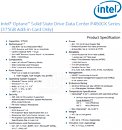Friday, February 10th 2017

Intel Optane DC P4800X with 3D XPoint Offers 21x Endurance Over MLC NAND
Intel is readying a fleet of new SSDs based on its new 3D XPoint non-volatile memory, a technology that Intel hopes will replace NAND flash in the years to come. The company developed this technology in collaboration with Micron Technology, under its IMFlash Technologies banner. The first Intel SSDs with this memory will be sold under the Optane brand. There are several sub-brands targeting the various market segments (client, enterprise, data-center, etc.), and technical slides of the data-center targeted Optane DC P4800X SSD were leaked to the web.
One of the first Optane DC P4800X SSDs comes in a rather measly capacity of 375 GB. The drive is built in the half-height PCI-Express add-on card (AIC) form-factor, with PCI-Express 3.0 x4 host interface. The drive belts out sequential transfer rates of up to 2400 MB/s reads, with up to 2000 MB/s writes, which may not sound like much given that even TLC NAND flash based PCIe 3.0 x4 drives offer higher transfer rates; until you look at three key metrics - latency, random-access performance, and endurance.
According to the specs-sheet of the Optane DC P4800X 375 GB AIC SSD, the drive offers over 21 times the endurance of comparable enterprise SSDs based on high-endurance MLC NAND flash; with a staggering 30 drive-writes per day (DWPD); and 12.3 petabytes (12,300 TB) total bytes written (TBW) rating. This is extremely high for a drive with just 375 GB of user-space. The random-access performance of the drive is also higher than competing MLC NAND flash based drives, with up to 550,000 IOPS 4K random reads, and up to 500,000 IOPS 4K random writes.
Source:
Tom's Hardware
One of the first Optane DC P4800X SSDs comes in a rather measly capacity of 375 GB. The drive is built in the half-height PCI-Express add-on card (AIC) form-factor, with PCI-Express 3.0 x4 host interface. The drive belts out sequential transfer rates of up to 2400 MB/s reads, with up to 2000 MB/s writes, which may not sound like much given that even TLC NAND flash based PCIe 3.0 x4 drives offer higher transfer rates; until you look at three key metrics - latency, random-access performance, and endurance.
According to the specs-sheet of the Optane DC P4800X 375 GB AIC SSD, the drive offers over 21 times the endurance of comparable enterprise SSDs based on high-endurance MLC NAND flash; with a staggering 30 drive-writes per day (DWPD); and 12.3 petabytes (12,300 TB) total bytes written (TBW) rating. This is extremely high for a drive with just 375 GB of user-space. The random-access performance of the drive is also higher than competing MLC NAND flash based drives, with up to 550,000 IOPS 4K random reads, and up to 500,000 IOPS 4K random writes.

14 Comments on Intel Optane DC P4800X with 3D XPoint Offers 21x Endurance Over MLC NAND
Btw, Samsung 3D NAND drives can go up to 1PB. So, it's not 21x really...
I be like "a cost/performance/capacity ratio that isn't 10x higher than industry standards..."
this is enterprise, by the time 3 years roll around its time to move to a newer faster setup.
There are other models with 10-20DWPD on SATA and NVME.
Most are still 3 or less. The consumer crappy drives mx line is more around 0.3 dwpd.
On the consumer end, the endurance numbers (the 850Pro in particular) confuses me to no end: on the 850 Pro for example, a mere 150TBW for 128GB to 1TB (at launch admittedly.. I'll give em some credit for revising the 512GB, 1TB and 2TB variants to 300TBW, but only a tiny bit). That translates to 0.3DWPD on the 120GB variant that scales right down to 0.0375 DWPD for the 1TB variant.
Seriously guys, just give me the damn number in DWPD. It's easier for everyone involved!
All that said, I've owned my 1TB 850 Pro for about 6 months now, and I haven't even cracked 6TiB written, so even with my somewhat silly usage it's nowhere near even 0.0375DWPD.